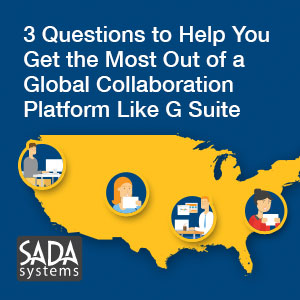
The workforce is increasingly global. Employees are increasingly on-the-go. Even within the same corporate campus, team members are asking for an increased capability to collaborate with each other. To meet these needs, many enterprise teams are turning to collaboration platforms like Google’s G Suite.
The right platform can help you and your team:
- Work from any location, from any device
- Synchronize your different teams located on opposite sides of the world (or opposite sides of the corporate campus)
- Increase your communication and productivity
- Manage your team’s goals, group projects, and individual milestones
- Collaborate with each other either in real-time, or asynchronously
However, you aren’t going to just pick a collaboration platform, make it available to your team, and then start measuring the ROI. Even the best-intentioned plans often go astray. Research shows that most organizations attempt to produce three or more big changes every year, but only about 30% of those changes actually stick and produce real results.
At SADA, we’ve helped many large organizations successfully integrate cloud collaboration platforms into their teams’ behaviors, business processes, and cultures. And in the process, we’ve identified three core questions that help teams get the most out of their new platforms:
- “What Core Benefit Do I Want to Get Out of My Platform?”
- “What Constraints Do I Have On My Collaboration Platform?”
- “How Will I Make Sure My Team Actually Uses My New Platform?”
Let’s dig into each.
Question 1: “What Core Benefit Do I Want to Get Out of My Platform?”
You’ve heard about all the benefits a collaboration platform like G-Suite can bring to your team. Increased sharing! Greater communication! Effortless collaboration! It’s natural to hear this list, get excited about the possibilities, and then attempt to and capitalize on your new platform’s every potential benefit from day one. Unfortunately, if you try to immediately milk your collaboration platform for every benefit it offers, you will most likely rush to produce too much change, too fast, and end up receiving none of the benefits you hoped for.
That’s why we like to start every collaboration platform implementation with executive workshops and trainings. There, we guide our clients’ leadership team through a simple, focused process. We help them identify the exact pain points they need their platform to solve. We help them identify the exact areas of opportunity their platform can offer real value. Finally, we help them craft a targeted vision of how their new system can best integrate into their organization, improve workflows and processes. After the dust has settled from go live, we offer end-user Transformation Labs where we assist individuals and teams to reengineer outdated and/or manual processes in G Suite.
In short: We help our clients get very specific about the few core benefits they need from their platform, and how their platform will provide those benefits. You don’t need to take a full set of executive workshops to begin focusing on what you need from your new platform, deciding what functionality will get you there, and then (temporarily) ignoring everything else. Just ask yourself: “What core benefit do I want to get out of my platform?” Once you answer this—with just one core benefit—it immediately becomes easier to start to focus in on how you’re going to use your platform on day one.
Here are a few common examples to kick off your brainstorming.
Let’s say you want to use your collaboration platform to expand your talent pool beyond local options. Then you can (temporarily) ignore getting your internal teams collaborating with each other on the platform, as you will instead focus on using your platform to plug your external teams into your existing internal workflows. But if you primarily need a new platform to better support your mobile staff when they work with clients, your approach changes entirely. You will first devote all your attention towards defining the core touchpoints where your platform can provide added support to your in-field staff. And then you will focus on perfecting those touch-points before you consider, say, how your platform can allow more of your in-office staff to work remote.
The Bottom Line: Get clear on what benefits you really need from your collaboration platform on day one, and ignore all the other “nice-to-have” benefits, to effectively focus your platform deployment.
Question 2: “What Constraints Do I Have On My Collaboration Platform?”
In a perfect world, you would only have to define your ideal benefits, map out a focused plan to reach them, and then deploy your new collaboration platform exactly how you want it. It’s a great dream… and it never happens like that. No team is an island, and your platform has to play nice with everyone else in your organization. If other teams in your organization are already using a different collaboration platform, you might have to use that platform instead of your own.
HR might already have a blanket policy on collaboration platform use, and this policy might clash with your dream implementation. Legal might raise an eyebrow about your desire to hire staff out-of-country, or even out-of-state, as labor laws vary from location to location. And, of course, IT will worry whether your desired platform integrates with the rest of your organization’s platforms…and how your platform will meet security standards… and whether your new platform will knock you out of compliance… and… well, you get the picture.
These internal constraints are important. Your existing client and customer constraints matter even more. Are they currently using a collaboration tool that they would prefer you adopted instead of your choice? Does your desired platform offer all the functionality they require? Can you even deploy a global team to serve your existing clients and customers, or do they really need to interface with a traditional workforce?
The Bottom Line: You likely have at least a few big constraints on what collaboration platforms you can use, how you can deploy them, and what benefits you will receive from them. The sooner you define your constraints, the sooner you can create a realistic picture for how to get the most out of your collaboration platform.
Question 3: “How Will I Make Sure My Team Actually Uses My New Platform?”
When a technology implementation fails, it’s usually an awareness problem. Sure, if you announce the deployment of a new collaboration platform everyone in your team will be “aware” it’s now available. But they need to be aware of more than that. Your team also needs to know why you are now using this new platform, what additional business value you want it to deliver, and how they are supposed to integrate the platform into new daily habits and business process.
We recommend you leverage a pretty robust change management plan to make sure your team uses your new platform (correctly) over the long haul. Here’s the basic process we recommend—and utilize—with all of our clients.
- Executive Workshops and Trainings: Mentioned above. We get the leadership team together to set down a real vision, strategy, and plan for getting the most out of their new platform.
- Executive Communications Strategy: We help our clients craft, and roll out, a top-down communications plan that answers all the common questions about the new platform, that generates excitement for its deployment, and to generally get—and keep—everyone on-board with the change.
- User Champions: The new platform’s adoption can’t be driven entirely from the top. We also make sure there are plenty of peer-to-peer sources of information and adoption assistance peppered throughout the organization.
- Awareness and Training: We all know it isn’t enough to say something once. We make sure our clients keep repeating their core messages about the new platform—in different forms and forums—and then measure engagement over time to make sure everyone’s on hearing the same things, and coming to the same conclusions, about the new platform.
- Boots on the Ground: Finally, we know your organization might not have the internal staff required to ensure a successful implementation. That’s why we provide many of our clients with dedicated systems experts to offer the necessary hands-on-support to drive their comprehensive change management program.
The Bottom Line: Change doesn’t just happen. It takes a big push. And if you don’t have the internal resources and skills required to make the change stick, then you have to find the right partner who can doing most of the pushing for you..
Bring These Benefits to Your Organization
At SADA Systems, we’ve spent over a decade helping companies implement large-scale technology-based transformations. We’d love to discuss whether our experience and skills can help you get the most out of your cloud collaboration platform.
For more information on how you can transform your organization with G Suite, click here for a free assessment today!



